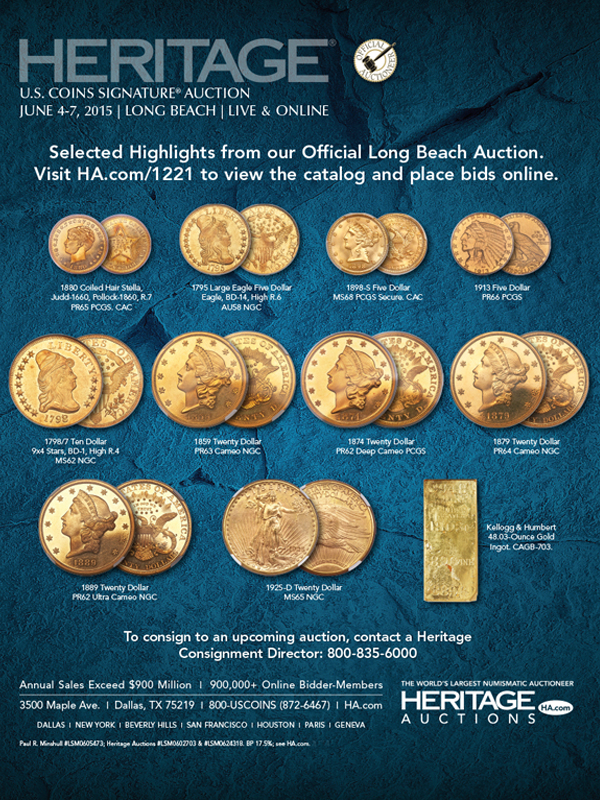
PREV ARTICLE
NEXT ARTICLE
FULL ISSUE
PREV FULL ISSUE
BANKNOTE ENGRAVER LORENZO HATCH
The May 2015 issue of The Numismatist from the American Numismatic Association has several nice articles, including John
Dannreuther's piece on the Evolution of the Peace Dollar. Another one I enjoyed is Remembering Lorenzo Hatch by A
Chinese bank-note engraver Qiming Zhao about his tour of the hometown of the American artist responsible for China’s steel-engraving
tradition. With permission, here's an excerpt. Many thanks to Senior Editor Jerri Raitz for forwarding the file. -Editor
As a gift for my 70th birthday, my son Rocky offered to be my interpreter on a trip to Dorset, Vermont, the hometown of Lorenzo Hatch (1856-1914). Many American numismatists will recognize the prominent, turn-of-the- century bank-note engraver and painter as the creator of the Ulysses S. Grant portrait featured on the face of Series 1886-91 $5 Silver Certificates and on the back of Series 1896 $5 Silver Certificates. Later in his career, Hatch was invited to China to help its government establish the Chinese Bureau of Engraving and Printing. I was taught engraving by an artist who had studied under the legendary Hatch, and it has been a long-cherished dream of mine to visit the artist’s birthplace. During our trip to America, we also toured the East Coast and explored a great variety of museums, galleries, mints and bank-note printing facilities. We arrived in Dorset on the evening of August 7, 2013. Jon Mathewson, curator of the Bley House Museum, and board members of the Dorset Historical Society were waiting for us. We shook hands and hugged, and Mathewson showed us around Hatch’s former home (now the office of Josiah Allen Real Estate) and his studio, which still stands in the backyard. The studio contained a skylight that was perfect for drawing, and Hatch’s easel was set up in the room as if he had never left. Mathewson suggested we visit the cemetery, so we walked to the graveyard at sunset as rays of golden light streamed through the trees and illuminated Hatch’s tombstone, which read: LORENZO J. HATCH JULY. 16.1856. FEB.1.1914. I bowed three times to pay my respects to the renowned artist who helped introduce the steel-engraving tradition in China. The next morning, we headed to the Bley House Museum. Mathewson had invited the retired curator, Richard Hittle, and his wife to join us. Maps of Dorset, unearthed relics and pictures of the Vermont town are displayed on the museum’s ground floor. The upstairs is home to Hatch’s works: bank notes, portraits, landscapes, oils, watercolors, sketches and other artwork. Next, we visited the Southern Vermont Arts Center, where many of Hatch’s portraits of his wife and mother are on exhibit. Hatch rendered many paintings of his mother that demonstrated his deep love for her. One of these pieces especially appealed to us—the warm hue and affable expression on his mother’s face were reminiscent of Rembrandt’s style. We admired Hatch’s work while listening to the curator’s live presentation about the artist and engraver, and were impressed by the museum’s holdings of many rare documents. Its collection includes small-size engravings, yellowed family correspondence, newspaper reports, and sketches, each of which conveyed bits of the engraver’s remarkable life story. We talked and shared stories about Hatch, many of which were not widely known, especially his tremendous contribution to China’s bank-note printing industry during his six years there. In the early 1900s, the Qing government decided to emulate advanced printing methods used in western countries and issued national currency notes controlled by the central government. The United States Bureau of Engraving and Printing (BEP) was famous for its intaglio bank notes produced from hand-engraved steel plates. Dr. Chen Jintao, the Yale-educated vice president of China’s Board of Finance, recommended building a printing facility based on the American model, using BEP methods to thwart counterfeiters. Lorenzo Hatch was a well-known American engraver whose skill was respected by Chinese officials. In 1908 the representatives visited Hatch on behalf of the Qing Dynasty and with the approval of the United States Department of the Treasury. They discussed setting up the operation, which would allow China to produce its own stamps and currency. After some initial reluctance, Hatch signed a six-year contract with the Chinese government. For more information on the American Numismatic Association, see:

Wayne Homren, Editor The Numismatic Bibliomania Society is a non-profit organization promoting numismatic literature. See our web site at coinbooks.org. To submit items for publication in The E-Sylum, write to the Editor at this address: whomren@gmail.com To subscribe go to: https://my.binhost.com/lists/listinfo/esylum All Rights Reserved. NBS Home Page Contact the NBS webmaster 
|